 |
||
|
||
| ||
 NVIDIA's decision to produce several versions of the GeForce2 MX processor has been supported by the majority of NVIDIA's partners dealing with the video card production. We have already considered this issue and spoken about the MX200/MX400 features. Note that the MX400 version differs from the GeForce2 MX in an increased core frequency (200 MHz) as well as in NVIDIA's recommendations to use faster memory modules for video cards based on this chipset (183 MHz instead of 166). Some manufacturers have supported these recommendations, and some have released cards on the GeForce2 MX400 with old 166-MHz memory. Here I should remind you the following case. You might remember the first release of the GeForce2 MX video card with 5 ns memory from Leadtek - the WinFast GeForce2 MX SH Pro. At that time the card made a stunning impression not only by the fact that Leadtek disobeyed the head and overclocked the GPU, but also by a performance increase, especially in the overclocked mode. Nevertheless, NVIDIA was dissatisfied, and today the market offers these cards with the same 5 ns memory but at 175/166 MHz, i.e. according to the standard. Besides, the installation of Samsung chips makes the overclocking potential similar to the traditional cards (the maximum of 210-215 MHz for memory). The same situation occurs in case of SUMA's cards. This vendor is producing the Platinum GeForce2 MX PowerUp with 5 ns memory but the frequencies are the same as in case of usual PowerUp cards: 175/183 MHz instead of expected 175/200 MHz. Apparently, despite the striving of manufacturers to improve the speed characteristics of their cards, NVIDIA prohibits it. But ASUSTeK Computer, in fact, the first NVIDIA's partner, has violated this taboo and has released a video card based on the GeForce2 MX400 - the ASUS AGP-V7100 Pro which is equipped with 4.5 ns (!) memory. I think, ASUSTeK wouldn't have made such step without NVIDIA's permission. That is why, in my opinion, the company will start the mass production of the cards with such a super-fast memory. Anyway, the vendor has already announced the startup of shipping of these cards. Despite such a short access time, it is still SDR-memory, that is why the performance will hardly go up sharply, especially considering that the price niche of the GeForce2 MX400 doesn't mean it. But this card is another attempt to increase the popularity of the GeForce2 MX, paled before that of the ATI RADEON LE. So, let's study the card itself: the ASUS AGP-V7100 Pro. CardThe ASUS AGP-V7100 Pro has an AGP x2/x4 interface, 32 MBytes SDR SDRAM memory located in 4 chips on the face side of the PCB. 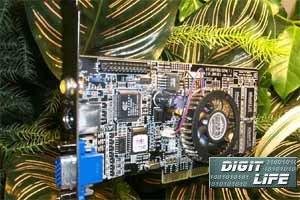 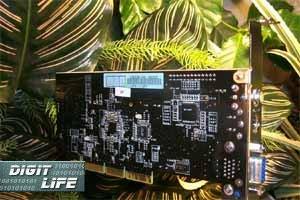 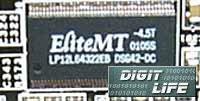 EliteMT produces memory chips with 4.5 ns access time which corresponds to 222 MHz. The memory works at 200 MHz. It is interesting to note that the fastest memory (not only DDR, but also SDR) used in video cards is produced by Elite Semiconductor. The memory, at the same time, has high technical specifications and a higher overclocking potential (remember, a 400-MHz memory reached 470 and even 480 MHz on the GeForce2 Pro cards!). Like in case of powerful cards with DDR-memory, the clock speed is not rated, it has a bit lower value in order to improve the stability of the card. At the first sight, the card's design seems to be corresponding to the reference one from NVIDIA. But there are some differences. First of all, it is the installation of two TV-out connectors: S-Video and RCA, which makes the card more attractive. Besides, the card is equipped with the SmartDoctor support - a status monitoring technology (on the rear panel there is a thermo control chip, and the cooler has a tachometer). The SmartDoctor is useful for monitoring the current temperature, voltage and cooler rotation frequency. But I don't recommend to use it all the time since the software part will constantly decrease the frequencies which may affect 2D graphics. Another peculiarity is the PCB color... We have already got used to yellow cards. This method to attract customers' attention was tested by ASUSTeK with the ASUS CULS2-C Black Perl mainboard, and proved to be good. And with the ASUS AGP-V7100 Pro the company has started a new tradition - the production of black cards. The card is equipped with a TV-out which differs in nothing, except the connectors, from traditional cards on NVIDIA processors. The GPU chip is furnished with a roundish cooler that has a very efficient fan. The card is shipped in a Retail-package, which includes:
OverclockingThe ASUS AGP-V7100 Pro managed to raise its frequency to 240/260 MHz. It is an absolute record among the GeForce2 MX cards! Of course, such frequencies can be achieved only due to the fast memory and the chipset which works at higher frequencies than a traditional GeForce2 MX. But anyway, the overclocking is impressing. That is why such overclocking can positively influence the performance in 3D. Installation and DriversThe test system configurations:
In the tests we used NVIDIA's drivers version 11.01; VSync was off. For comparison we have taken the results of the following cards: the AOpen PA256 Deluxe (GeForce2 GTS), Leadtek WinFast GeForce2 MX/DVI, SUMA Platinum GeForce2 MX200, SUMA Platinum GeForce2 MX400. Test ResultsThe 2D graphics quality is perfect, it can be compared with that of the GeForce2 MX cards. Note that 2D quality depends greatly not only on the manufacturer but also on a definite sample of the card. Besides, before accusing your card of all problems check whether your monitor corresponds to the requirements you establish for your video card performance. The following programs were used to estimate the 3D quality:
Quake3 Arena
demo002The tests were carried out in two modes: Fast (shows card's work at 16-bit color) and High Quality (shows card's work at 32-bit color). 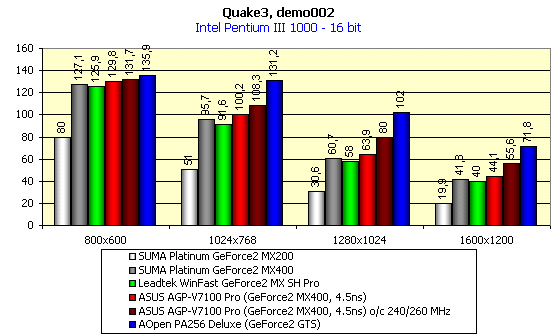 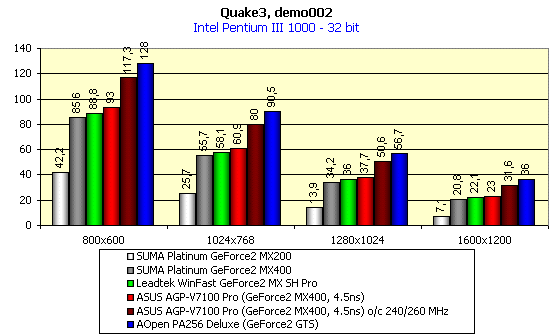 The SUMA Platinum GeForce2 MX400 has frequencies equal to 200/183 MHz. i.e. a bit lower than in case of the ASUS AGP-V7100 Pro (200/200 MHz). But at 16-bit color both cards were at the same level, though beaten by their elder brother - the GeForce2 GTS. But at 32-bit color the situation is a bit different, the ASUS AGP-V7100 Pro has taken the second place after the GeForce2 GTS. The overclocking has helped this card exactly at 32-bit color which made the 1024X768X32 resolution playable in all games (and some games work perfectly even at 1280X1024X32). GiantsThis game is used to show the card's speed in Direct3D. All settings are set to maximum that is why the test is very tough for many video cards. Hardware T&L is enabled. 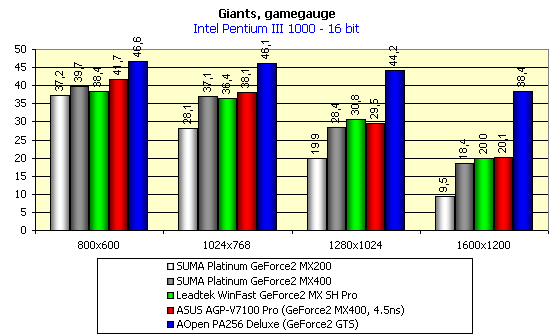 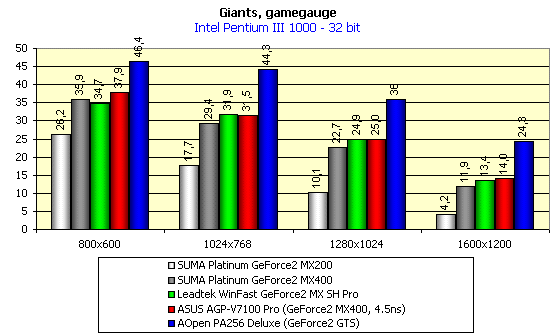 As you can see, a heavy load has brought to naught all the advantages in frequency of our card, and all the GeForce2 MX cards have performed equally (except the MX200 with its shortened bus). And the lead of the GeForce2 GTS is much more notable now. However, the GeForce2 MX cards weren't intended for tough games at high resolutions. ConclusionAs you can see, the company is striving for making their products more attractive without much increase in price. The price of the ASUS AGP-V7100 Pro won't be much higher than that of the usual V7100, but its capabilities and, especially, overclocking potential will please end users. Taking into consideration the traditionally high quality of similar cards from ASUSTeK, this card can be a very good choice for an average gamer who doesn't aim at high resolutions in games. Besides, a new aggressive NVIDIA's price policy will quickly bring the ASUS AGP-V7100 Pro's price to $100. In our 3Digest you can find a full comparison of specifications of this and other classes cards. Highs:
Lows:
Write a comment below. No registration needed!
|
Platform · Video · Multimedia · Mobile · Other || About us & Privacy policy · Twitter · Facebook Copyright © Byrds Research & Publishing, Ltd., 1997–2011. All rights reserved. |